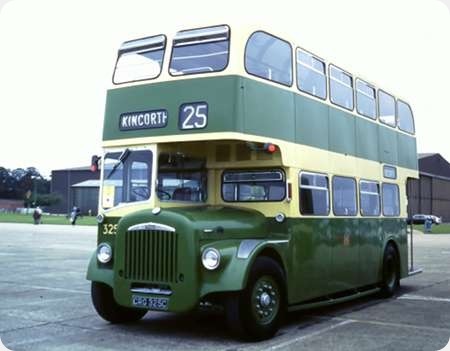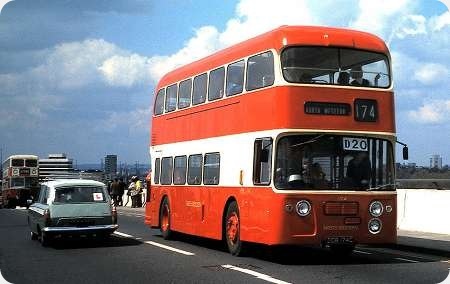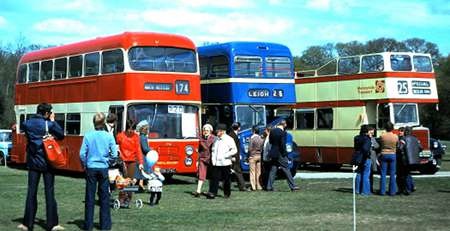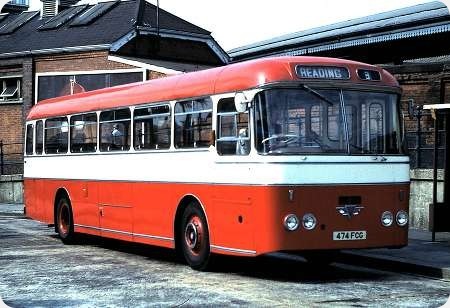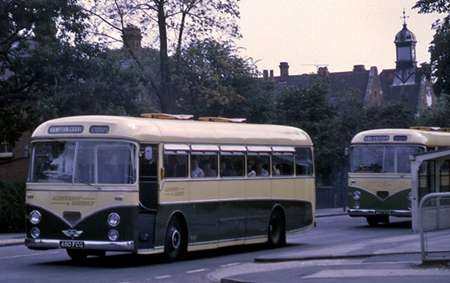Aberdeen Corporation – Daimler CV – CRG 325C – 325
Aberdeen Corporation
1965
Daimler CVG6
Alexander H37/29R
CRG 325C is a Daimler CVG6 with Alexander H66R bodywork. She entered service with Aberdeen in March 1965. This was one of only three or four Councils in Scotland still with its own Transport Department at Local Government Reorganisation in 1975 [a year later than in England] the undertaking was renamed Grampian Regional Transport, a precursor of First. We see her at Duxford on 18 September 2005.
Photograph and Copy contributed by Pete Davies
05/10/15 – 06:21
"Trafficators" on the mirrors? -about 40 years ahead of its time.
What’s the metal "pad" on the mudguard for? Not seen that before- and the grilles under the canopy are presumably heating…. and a ventilator in that window, too.
All together though, a very handsome bus: the tin front- perhaps plastic front- Daimler CV’s were the best looking half cabs of all (discuss).
Joe
05/10/15 – 06:22
Makes you wonder how they managed to fit 66 seats into a 27′ long decker. The Sheffield standard for buses of this length was 59 and I don’t recall the seat spacing being all that generous.
Ian Wild
05/10/15 – 09:51
I did wonder if, perhaps, the vehicle should be listed as a 30 footer, but a number of other places managed to fit sixty-odd seats in that length, cramped as it might have been. Did she start as a 58 or 59 seater and get the capacity increased for normal duties, was she for school services only in later years, or is there some other reason? Are there any readers out here who can tell us for sure?""
Pete Davies
06/10/15 – 06:31
Samuel Ledgard had several 27 footers with similar large capacities and, as far as I recall from conducting/travelling, no problem with legroom
The vehicles were :-
1949 – 1954 Regent V/Roe H37/28R
XUG 141 Daimler CVG6/Burlingham H36/28R
SDU 711 Daimler CVG6/Willowbrook LoLite H37/29RD.
The quite appreciable difference in the fairly narrow "window" of 26/27 feet is fascinating and quite remarkable.
Chris Youhill
06/10/15 – 06:32
Simple explanation for the "trafficators" on the mirrors. They are not trafficators but luminous yellow blobs as fitted to the back of the mirrors, a forerunner of the reflective yellow mirrors fitted to First vehicles. I believe that some other operators put aluminium plates on the near side wings, from memory Sheffield Regent V’s had them fitted but they did not cover the same area as those fitted to 325,and to all other Aberdeen tin front buses. Dundee buses also had fitting similar to those fitted in Aberdeen.
I presume it enabled staff to stand on the wings without scratching or breaking them.
325 was always a 66 seat bus and is only 27 ft. long. Aberdeen fitted five rearward facing seats along the front bulkhead
Further note, the luminous blobs have now been removed. At the time the picture was taken it was still owned by First, hence the luminous blobs. It is now owned by the Aberdeen and District Bus Preservation Group and is kept at the premises in Alford, Aberdeenshire.
Stephen Bloomfield
06/10/15 – 06:34
Halifax Corporation’s last five CVG6/Roe’s of 1956 had 65 seats (H37/28R) and were 27 footers. The lower deck comprised five pairs of double seats facing forwards and two sideways facing seats for four (a bit optimistic)over the rear wheelarches. The upper deck had eight pairs of forward facing seats, a double seat on the nearside opposite the top of the stairs (which were of course of the Roe straight variety) and a three seater seat at the rear, set back slightly behind the top of the stairs.
The Aberdeen example shown could have managed 66 seats using the same arrangement but with the first row of downstairs seats replaced by a five seater rearward facing seat against the front bulkhead.
John Stringer
06/10/15 – 06:34
The odd number of seats downstairs suggests that they had a reversed 5-some across the front bulkhead. Combined with inadequate leg room to the first forward facing seats (interlocking knees!) would give a "good" seating capacity there. We should not forget that even among the Scots, Aberdonians have a reputation to maintain! (An Aberdeen breakfast is said to comprise a slice of toast – no marmalade!)
Stephen Ford
06/10/15 – 06:35
65 seats on a 27-ft rear entrance double decker was fairly common. The extra seat to give 29 downstairs was usually achieved by having a rear facing five seat bench across the front bulkhead, Lodekka style. I am not personally familiar with these buses but would assume that was the layout.
Philip Halstead
06/10/15 – 07:06
The London Routemaster had 64 satisfactorily spaced seats within an overall length of 27 ft 8 ins, so I suppose the quoted figure of 66 in the Aberdeen Daimler’s Alexander body was possible, even if not entirely comfortable. On the subject of tin/plastic fronts, I thought most of them were pretty dire, and the AEC variety, often quoted by many enthusiasts as their favourite, was garish in the extreme to my eye. It was just an over inflated caricature of the contemporary Rover car front end. My own preference from the mediocre line up was the Johannesburg front on the Guy Arab, but this wasn’t offered for very long before the old Birmingham style became standard again.
Roger Cox
06/10/15 – 07:06
I would hazard a guess that the metal plate on the nearside mudguard was a canny Scottish idea to reduce damage to the paintwork by Fitters in dirty overalls whilst working on the engine (or night staff leaning over to check/top up the engine oil level). Seems a logical idea, did any other Operators fit these plates?
Ian Wild
06/10/15 – 07:07
With bodies by Park Royal and Willowbrook on a Guy Arab IV or Leyland PD2/12 chassis, the 1956/7 intake of D/D’s for the NGT group were all 63 seats, but 66 would seem a bit cosy, or should that be cramped?
Ronnie Hoye
06/10/15 – 07:07
Manchester Corporation and others had 65 seat 27 foot double-deckers. If the downstairs front seats had been turned to face backwards as a five seat bench (as on Bristol Lodekkas) they would have seated 66.
Don McKeown
06/10/15 – 09:39
Interesting information on the variations in these apparently high capacities. Of the eight Ledgard vehicles I mentioned only the Willowbrook "LoLite" body had the rearward facing seat for five behind the driver.
Chris Youhill
07/10/15 – 06:20
Chris-do tell us more about "LoLite" bodies? I tried it in Google and got a page of searches based on Lolita. At first glance, the word looks like one for a vandal-proofed body suitable for the more difficult-to-conduct routes.
Joe
07/10/15 – 06:22
Reading about these "large" capacity buses has me wondering about the "moderns"(sorry about that) that I am seeing around Lancashire.
A company called Tyrer has a 3axle DD marked on the back as a 102 seater and their company website has a picture of a similarly 3axle 100 seat executive coach.
Does anybody know what they might be.
John Lomas
07/10/15 – 15:54
Joe – the one that Ledgard had (SDU 711, later West Yorkshire after takeover, was the former Daimler demonstrator. The low height was, as far as I remember, achieved very successfully by attaching the body direct to the top of the chassis members. It was a very good looking bus, looking "comfortable" with itself, and was extremely strongly built with substantial upper saloon corner pillars.
John – the giant 100 seats plus buses that you mention sound very like some re-imported from China, possibly Dennis Dominators or Ailsa Volvos – open to correction there.
Chris Youhill
08/10/15 – 07:22
One of the views on the firm’s website shows the cab area, with something like the Volvo logo on the steering wheel.
Pete Davies
08/10/15 – 07:23
The 100+ three-axle vehicles are probably from Hong Kong where this type has been common for several years. The high seating capacity is mainly achieved by the use of three and two seating across the bus. With the population of Hong Kong being generally smaller in build than us Europeans this works over there. Think it would be a bit cramped with British bus loads though.
Philip Halstead
09/10/15 – 17:17
With a little help from Pete, these are apparently new Volvo B9TL tri-axle deckers, bodied by East Lancs. Quite a good-looking bus, but I much prefer the look of the Southdown East Lancs bodied Royal Tigers and PD2/12’s found in the 50’s and 60’s when I was a wee lad growing up in Brighton.
Anon
28/10/15 – 13:27
Growing up in Aberdeen in the 60’s I can confirm that Grampian 325 had three seats at the rear of the top deck and a rear facing 5 seat bench behind the lower deck bulkhead. Also 325 was the last open platform bus delivered in Scotland.
Danny Stephen
29/10/15 – 06:25
I notice that CRG 325C has the wider form of the so-called "Manchester front". We’ve been discussing this subject over on the sct61 site. The conclusion so far is that the standard CVG6 had a chassis frame that tapered towards the front and used a 7’6" front axle. When a change had to be made to the chassis frame design for any reason, a straight frame was used with an 8′ axle and the wider cowl. Examples explained this way are for 30-foot chassis, manual gearboxes and forward entrances, and also for the final batch for Northampton which was simply using up parts.
That seems to make these Aberdeen examples the last unexplained anomaly, unless anyone has any ideas.
Peter Williamson
Quick links to the - Comments Page - Contact Page - Home Page
